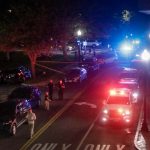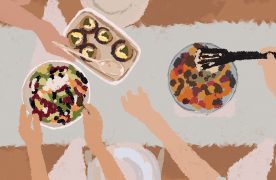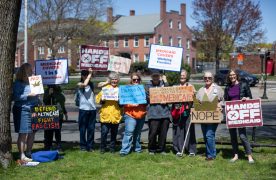North Pleasant Street, known as “frat row” to students at the University of Massachusetts-Amherst, will receive a makeover after the school’s administration announced it will demolish several buildings on the street.
According to Michael Wiseman, the director of the Office of Fraternities and Sororities at UMass-Amherst, the five fraternity and sorority houses to be demolished have already been emptied.
Wiseman said the five houses are owned and leased from one UMass affiliated corporation.
“The corporation decided they didn’t want to own these houses [any longer],” Wiseman said. “So they put the houses up for sale [and they] had been on the market for 2 or 3 years.”
Wiseman said the university bought the land and may be used to build academic or administrative buildings, adding “the university is always interested in expanding, so when these properties became for sale, they were very convenient because they are adjacent to campus.”
According to a Sept. 11 Boston Globe article, UMass “has been eyeing the land for at least a decade.”
According to Wiseman only three out of the five houses were being rented at the time of the sale. One of the three houses was able to relocate to another location while the other two are currently operating without a house.
UMass is currently engaging in “formal talks” with the property owner and the “multimillion-dollar sale” is slated for completion next spring, according to the same Globe article.
According to Wiseman, the five houses are older wood-frame structures that have been through a lot of “use and abuse over the years.”
Courtney Savas, a UMass senior, agreed that the houses on frat row needed plenty of repair.
“Honestly, a lot of people liked frat row,” Savas said. “But it was disgusting. There were holes in the floors and they were always sticky.”
“God forbid you ever had to go to the bathroom while at a party there — there’s a reason they shut those houses down,” she added.
Yet Wiseman said that, while these fraternities lost their chapter houses, it is not the end of the party scene at UMass.
“This is one step in a series of many steps to bring our fraternity system to a different place,” Wiseman said. “As a system we are trying to market ourselves better.”
“This is not the end of our fraternity and sorority system,” he added. “We are still here and we are still recruiting people and adding chapters. The party’s not over — it’s just looking different now.”
While schools like UMass have historically had chapter houses for its fraternities and sororities, many Boston schools, including Northeastern University, have never had houses for their chapters.
According to Tom Kelly, the Greek Council Chair at NU, only one of their 17 chapters has a house.
“Now that doesn’t stop chapters from living in clusters,” Kelly said. “[For example] four people from one chapter could get an on-campus apartment together.”
Kelly added the university may look into having Greek-themed housing in dormitories.
According to Kelly, about 5 percent of NU’s student body is currently involved in Greek life.
According to Dina Marcinek, the coordinator of Greek Programs in Boston University’s Student Activities Office, while BU currently does not recognize any fraternity or sorority houses, Greek life is still the largest student group on campus.
“Right now it makes up about 4 percent of the BU undergrad population,” Marcinek said.
“BU recognizes 8 fraternities and 9 sororities,” she continued. “The feedback I’ve gotten from many chapter members is that being part of their chapter has made BU feel [less huge] and provided them with many connections.”
In September of 2005, Dean of Students Kenneth Elmore suspended the number of fraternities and sororities on campus for an indefinite amount of time, saying: “We’re not saying we don’t want any more fraternities and sororities ever, but we want to make sure we have a good, strong, solid set of fraternities and sororities on campus first.”
This is an account occasionally used by the Daily Free Press editors to post archived posts from previous iterations of the site or otherwise for special circumstance publications. See authorship info on the byline at the top of the page.













